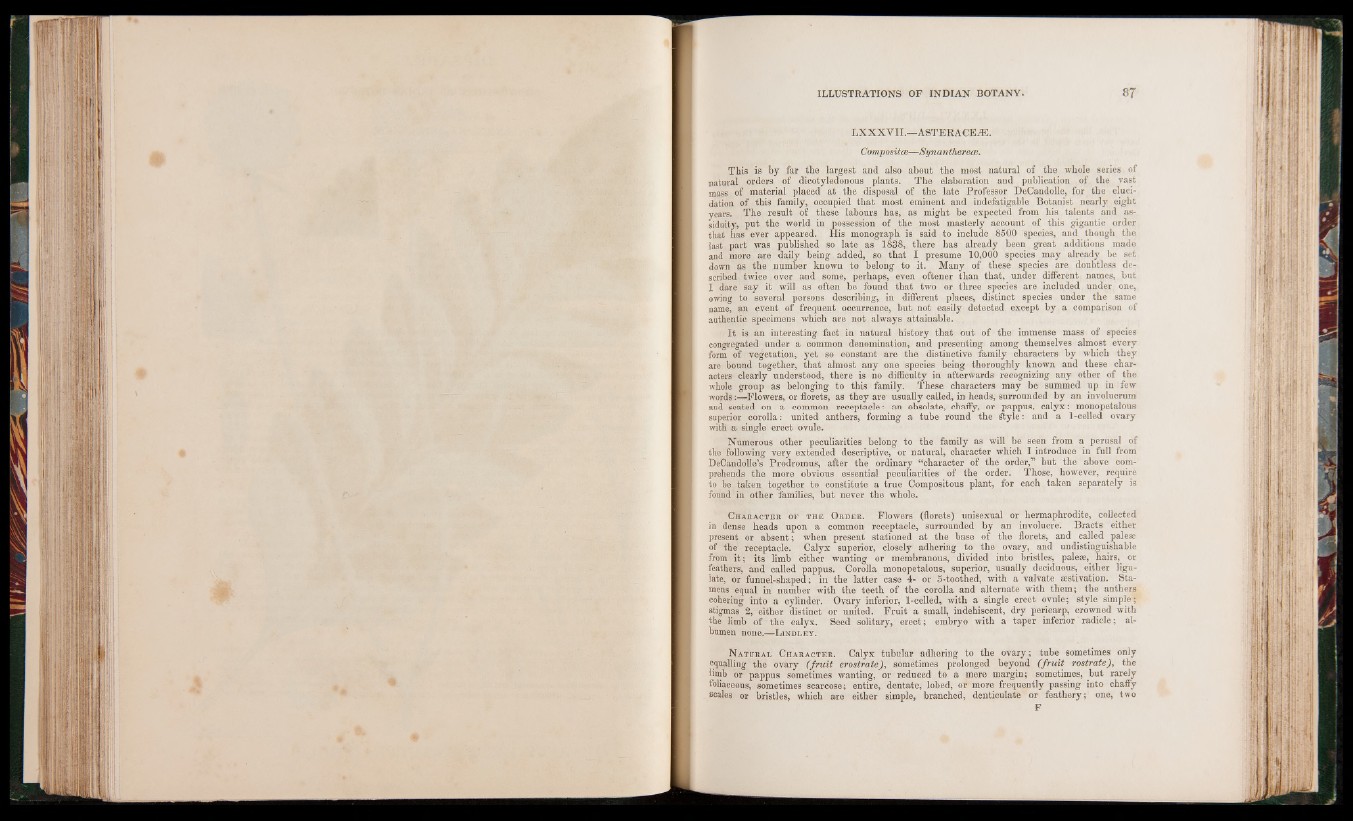
LXXXVII.—ASTERACEiE.
Composites—Synantherece.
This is by far the largest and also about the most natural of the whole series of
natural orders of dicotyledonous plants. The elaboration and publication of the vast
mass of material placed at the disposal of the late Professor DeCandolle, for the elucidation
of this family, occupied that most eminent and indefatigable Botanist nearly eight
years. The result of these labours has, as might be expected from his talents and assiduity,
put the world in possession of the most masterly account of this gigantic order
that has ever appeared. His monograph is said to include 8500 species, and though the
last part was published so late as 1838, there has already been great additions made
and more are daily being added, so that I presume 10,000 species may already be set
down as the number known to belong to it. Many of these species are doubtless described
twice over and some, perhaps, even oftener than that, under different names, but
I dare say it will as often be found that two or three species are included under one,
owing to several persons describing, in different places, distinct species under the same
name, an event of frequent occurrence, but not easily detected except by a comparison of
authentic specimens which are not always attainable.
It is an interesting fact in natural history that out of the immense mass of species
congregated under a common denomination, and presenting among themselves almost every
form of vegetation, yet so constant are the distinctive family characters by which they
are bound together, that almost any one species being thoroughly known and these characters
clearly understood, there is no difficulty in afterwards recognizing any other of the
whole group as belonging to this family. These characters may be summed up in few
words:—Flowers, or florets, as they are usually called, in heads, surrounded by an involucrum
and seated on a common receptacle: an obsolate, chaffy, or pappus, calyx: monopetalous
superior corolla: united anthers, forming a tube round the gtyle: and a 1-celled ovary
with a single erect ovule.
Numerous other peculiarities belong to the family as will be seen from a perusal of
the following very extended descriptive, or natural, character which I introduce in full from
DeCandolle’s Prodromus, after the ordinary “character of the order,” but the above comprehends
the more obvious essential peculiarities of the order. Those, however, require
to be taken together to constitute a true Compositous plant, for each taken separately is
found in other families, but never the whole.
C h a r a c t e r o f t h e O r d e r . Flowers (florets) unisexual or hermaphrodite, collected
in dense heads upon a common receptacle, surrounded by an involucre. Bracts either
present or absent; when present stationed at the base of the florets, and ealled . paleas
of the receptacle. Calyx superior, closely adhering to the ovary, and undistinguishable
from it; its limb either wanting or membranous, divided into bristles, palern^ hairs,f or
feathers, and called pappus. Corolla monopetalous, superior, usually deciduous, either ligu-
iate, or funnel-shaped; in the latter case 4- or 5-toothed, with a valvate aestivation. Stamens
equal in number with the teeth of the corolla and alternate with them; the anthers
cohering into a cylinder. Ovary inferior, 1-celled, with a single erect ovule; style simple;
stigmas 2, either distinct or united. Fruit a small, indehiscent, dry pericarp, crowned with
the limb of the calyx. Seed solitary, erect; embryo with a taper inferior radicle; albumen
none.—L in d l e y .
N a t u r a l C h a r a c t e r . Calyx tubular adhering to the ovary; tube sometimes only
equalling the ovary (fruit erostrate) , sometimes prolonged beyond (fru it rostrate) , the
limb or pappus sometimes wanting, or reduced to a mere margin; sometimes, but rarely
foliaceous, sometimes scarcose; entire, dentate, lobed, or more frequently passing into chaffy
scales or bristles, which are either simple, branched, denticulate or feathery; one, two
F